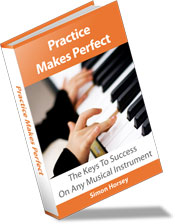Speeding up a piece or scale
There is a school of thought that recommends speeding up a piece or scale gradually using a metronome, one beat per minute at a time. The recommendation is you begin playing with the metronome set at a speed within your capability to get all the notes correct. Play through the section. If you get all the notes correct at that speed, move the metronome up by one click, or one beat per minute (bpm) on an electric metronome and play again. The speed difference is so small you hardly notice and can play through again at the new tempo. Keep doing this until you can’t play everything correctly and note what speed you have achieved.
The advantage of this technique is that you (hopefully!) end up playing sections or whole pieces totally correctly many times over. Speeding up a piece using this method is also like a game. You know your target speed and it is a challenge to see how far you can get towards it in a session. Challenge and a clear target are excellent motivators when practising.
But...
Doesn’t there always have to be a ‘but’?
The trouble with this method is that on many instruments the techniques for playing slowly and quickly may be slightly different. As you speed up gradually you continue using the slow playing technique instead of a technique more suited to a faster tempo. This can lead to muscle tension when you play, especially on the piano, incorrect tonguing on wind instruments and tension and incorrect bowing on string instruments.
The problem is often not even seen as one of technique. For instance, on a string instrument such as the violin, the comment below is correct, the technique is the same. But the amount of bow used would be very different at a much higher speed. If you have practiced using long bowing strokes because the tempo is slower you will have muscle memory for long bowing strokes. When you suddenly need to play the passage fast, the bowing strokes would need to be shorter and you would need to relearn the bowing.
Think about the end technique
The key when speeding up, is to think about what your final movements will be and be sure to replicate these when playing slowly. Seek advice from your teacher or play through a similar passage you can already play and think about the techniques you are using, then apply these to your practice of the new passage.
Relax
You need to have minimum tension in your body when you play for the sound, the audience and the good of your body. Having excess tension in your body when you play may lead to physical injuries in the long run such as repetitive strain injury and other tension problems in the body.
Expert Practice Secrets
Frustrated with your practice? Read Practice Makes Perfect and hack the 10,000 hour rule. Cut your practice time by up to 25%! Make faster progress, learn pieces and scales faster, memorize more easily, and much more. "If you play an instrument you need this book!"
Recent Articles
-
Curdridge Parking
Jul 10, 25 06:11 PM
-
How To Speed Up Scales and Improve Accuracy
Oct 13, 24 04:23 AM
How to speed up scales is something many people want to know, but speed should also come with accuracy. Read on to find out how to do both. -
From an opera singer, on her death bed to Leonard Bernstein
Jan 29, 24 03:36 PM
I enjoy reading the music more than hearing it. From an opera singer, on her death bed to Leonard Bernstein

New! Comments
Have your say about what you've just read!Leave me a comment in the box below.